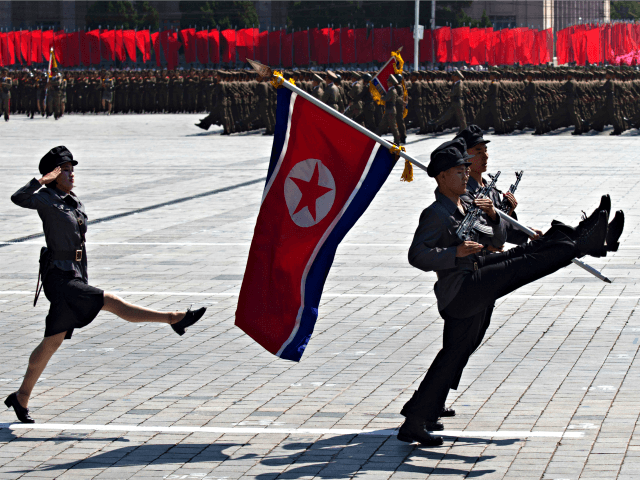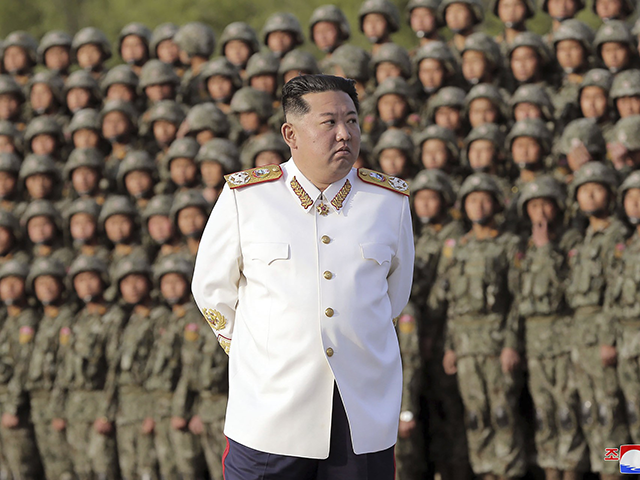North Korea must make “full war preparations” to “overwhelmingly contain and destroy the enemy,” communist dictator Kim Jong-un demanded in a meeting of his top military leaders on Wednesday.
The country’s state newspaper Rodong Sinmun reported that Kim presided over the Central Military Commission meeting personally, ousting his chief of general staff, General Pak Su-il and replacing him with a deputy, Vice Marshal Ri Yong-gil. Pak was purged among several other “leading commanding officers,” which Rodong Sinmun did not name. Observers outside of North Korea have not indicated that the shake-up suggests any large-scale controversy or conflict between Kim and his generals.
Kim’s command to prepare for war follows a year of rapidly escalating tensions between North and South Korea that began with Kim demanding an “exponential increase” in the number of nuclear weapons North Korea possesses and has led to South Korean President Yoon Suk-yeol threatening to “end” Kim’s regime while onboard an American nuclear submarine in July.
Yoon, a conservative, took office in May and has since prioritized undoing leftist predecessor Moon Jae-in’s concessions to the communist North, including limiting military cooperation with the United States and preventing South Koreans from sending humanitarian aid balloons across the border.

File/Soldiers march in a parade for the 70th anniversary of North Korea’s founding day in Pyongyang, North Korea, Sunday, Sept. 9, 2018. (Korean Central News Agency/Korea News Service via AP)
The meeting on Wednesday also followed two weeks of significant escalation in belligerent rhetoric as the two Koreas marked the 70th anniversary of the armistice agreement that ended active hostilities in the Korean War. The agreement created the Demilitarized Zone (DMZ) between the two countries and created what has become a permanent U.N. Command and American military presence in South Korea. It has not resulted in a peace treaty or the surrender of either side at press time. Despite this, North Korea celebrates the anniversary as “Victory Day” and held a lavish military parade in late June to show off its most modern weapons. Among those displayed was the “Hwasong-18,” a new intercontinental ballistic missile (ICBM) model that the U.N. has warned could “reach most points on Earth.”
According to Rodong Sinmun, Kim Jong-un is seeking for his officers to prepare for full-scale war. The Central Military Commission meeting, it claimed, had as its “major agenda item the issues of making full war preparations to neutralize at a blow the enemy attack with overwhelming strategic deterrence and launch simultaneous offensive military actions in contingency.”
The dictator demanded that the army “more thoroughly gird for a war given the grave political and military situation prevailing in the Korean peninsula.”
“The meeting examined a plan of forming frontline operation groups reinforced to overwhelmingly contain and destroy the enemy with absolutely superior military strategy, tactics and muscle in contingency,” the newspaper continued, “and the operational tasks to be fulfilled in carrying it out.”
Kim reportedly tasked his soldiers with “containing the enemy’s use of military muscle in advance and neutraliz[ing] all forms of its attack at once in case of the outbreak of a war.”
“[H]e called for securing more powerful strike means for carrying out the mission of war deterrence and continuously intensifying the work for deploying them in the units for action in a mobile way,” it added. Specifically, Kim demanded his forces “push ahead with the mass-production of various weapons.”
While referring to the need to expand North Korea’s “deterrent” power, a euphemism for nuclear weapons, the state newspaper did not quote Kim specifically requesting his team build more nuclear weapons. He had already issued that command at a Workers Party’ of Korea (WPK) meeting in December, however, to map out plans for 2023.
Kim also did not reportedly specifically mention which enemies North Korea should prepare for war against, but images published in Rodong Sinmun showed Kim pointing at a map, apparently highlighting Seoul.
BREAKING: Kim Jong Un convenes an enlarged Central Military Commission meeting to discuss “more powerful striking means” against adversaries on the Korean Peninsula, announces next military parade for September. FULL STORY SOON @nknewsorg pic.twitter.com/pAAhvLyNVY
— NK NEWS (@nknewsorg) August 9, 2023
The South Korean newspaper JoongAng Daily noted that the timing of the alleged war plans precedes two major events in South Korean-American relations: joint military exercises scheduled for late August, dubbed “Ulchi Freedom Shield,” and a meeting bringing together Yoon, leftist American President Joe Biden, and conservative Japanese Prime Minister Kishida Fumio. The two Asian leaders are expected to fly to Camp David for conversations with Biden on August 18. Japan and South Korea have long maintained friendly relations with America but poor ties to each other, as Imperial Japan committed a host of human rights atrocities against Koreans before the end of World War II. Yoon has endeavored to improve relations with Japan, however, in light of mutual threats from both North Korea and communist China.
A South Korean Unification Ministry official responded to Kim’s display on Wednesday in remarks to the South Korean news agency Yonhap, suggesting that increased belligerence from Pyongyang would escalate the potential for conflict.
“North Korea should realize the more it prepares for war and seeks to bolster its military force, the more vulnerable its security will be in the face of a powerful South Korea-U.S. extended deterrence and overwhelming response,” the official said.
Yoon’s administration has repeatedly stated that North Korea’s communist regime would not survive a nuclear attack on Seoul or Washington. Yoon himself made the threat most recently while aboard the USS Kentucky, an American nuclear-powered submarine which made a stop in Busan, South Korea, in July.
“The two countries will overwhelmingly and resolutely respond to North Korea’s advancing nuclear and missile threats through the NCG [Nuclear Consulting Group] and regular deployments of strategic assets, such as the SSBN,” Yoon said during his visit to the vessel. “By doing so, we will make North Korea not even dream of carrying out a nuclear provocation, and we warned clearly that should North Korea carry out a provocation, it will lead to the end of that regime.”
The NCG is a new body created following Yoon’s visit to Washington this year, intended to give Seoul more leverage and information regarding American assets in South Korea. The creation of the NCG was one of several concessions Biden granted Yoon after he began publicly suggesting that Seoul was considering developing its own nuclear weapons rather than relying on America’s.
North Korea, through its defense minister Kang Sun-nam, responded to the presence of the USS Kentucky by threatening a nuclear attack.
“[T]he ever-increasing visibility of the deployment of the strategic nuclear submarine and other strategic assets may fall under the conditions of the use of nuclear weapons specified in the DPRK [North Korea] law on the nuclear force policy,” Kang wrote in a statement. “The DPRK’s doctrine on the use of nuclear weapons allows the execution of necessary action procedures in case a nuclear attack is launched against it or it is judged that the use of nuclear weapons against it is imminent.”

COMMENTS
Please let us know if you're having issues with commenting.